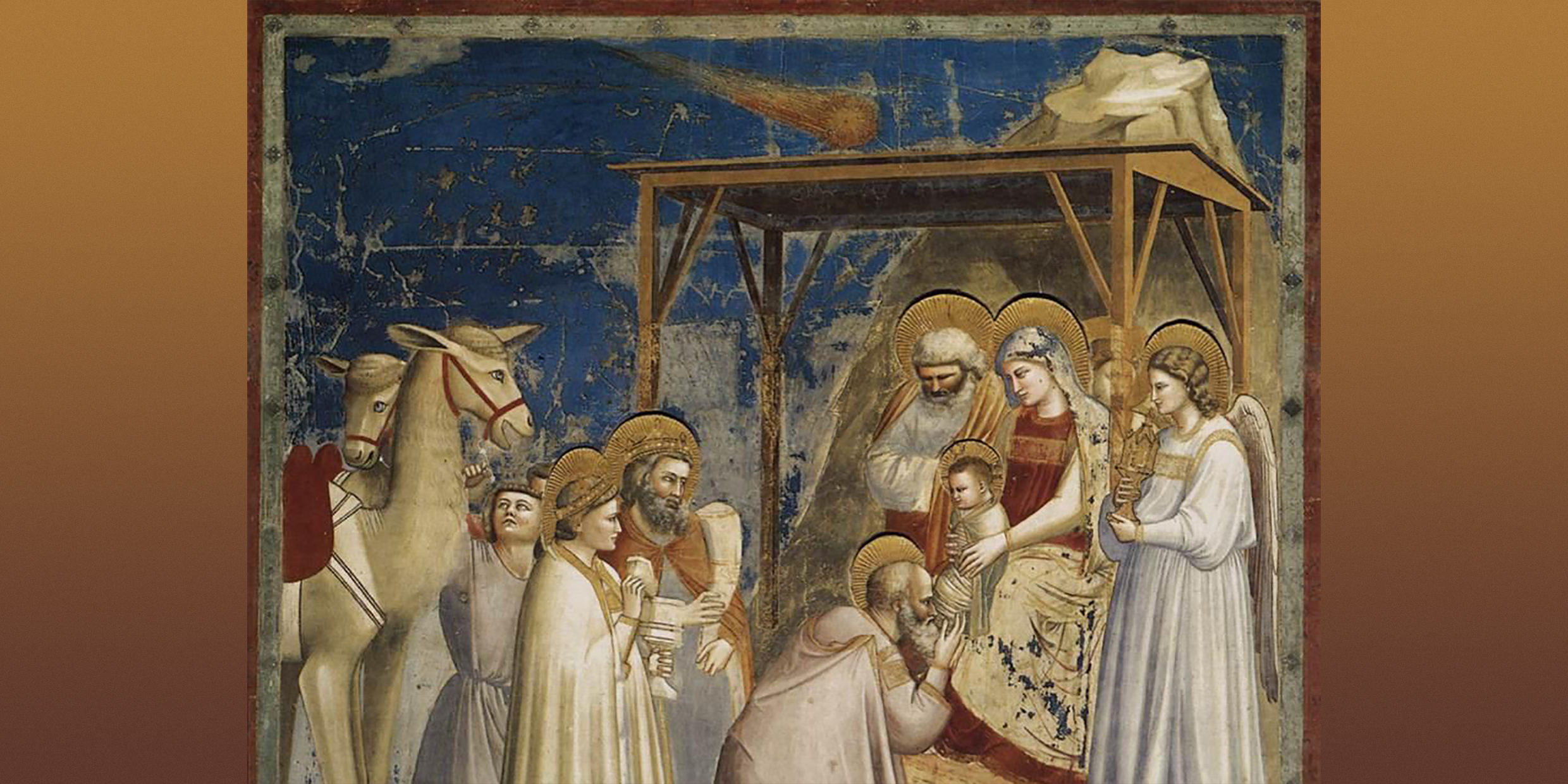Originally published 26 December 1988
In the year 1303, Enrico Scrovegni, a businessman of Padua, Italy, commissioned the construction of a chapel, partly to expiate the sins of his father, a notorious money-lender assigned by the poet Dante to the seventh circle of Hell.
The building is known today as the Arena Chapel. It is decorated with frescoes by the artist Giotto di Bondone, showing scenes from the lives of Mary and Christ. One of these, the Adoration of the Magi, is famous for the special nature of its Christmas star.
The celestial object that hovers over the stable at Bethlehem is not the traditional many-pointed star with rays streaming down toward the Christ child, but a remarkably realistic comet. Its “rays,” or tail, point upward into the evening sky, exactly like the tail of a real comet streaming away from the setting sun.
Roberta Olson, an art historian at Wheaton College in Norton, Ma., has convincingly argued that the “star” in Giotto’s painting is Comet Halley (Scientific American, May 1979). Guy Ottewell and Fred Schaff, authors of Mankind’s Comet, a comprehensive historical and astronomical survey of Comet Halley, agree that Halley was probably Giotto’s inspiration.
Comet Halley appeared in Italian skies in the year 1301, only a few years before Giotto began his Paduan frescoes. At that time the painter was probably in Florence, and may have observed the comet in the company of Dante, who also resided in that city.
Idea not farfetched
With the help of a star globe and Ottewell and Schaff’s charts, I reconstructed what Giotto might have seen. The comet was brightest in late September, appearing low in the northwest after sunset, with the tail streaming upward toward the Big Dipper. The posture of the comet in the sky was similar to that of the comet in Giotto’s painting, although reversed left to right, presumably for compositional reasons. The coma and tail of Giotto’s comet are strikingly similar to photographs of Comet Halley made during the 1910 apparition.
Giotto’s use of a comet as the Christmas star was not farfetched. Comets had long been associated with the births of kings and commencements of new dynasties. Several early Christian theologians had assumed that a comet prefigured the birth of Christ. In Giotto’s time, the periodic nature of comets was not yet recognized, and the mysteriously beautiful object hanging low in the western sky must have seemed an adequate model for the Christmas star.
The artist may have been more correct than he realized in choosing Halley to announce the birth of Christ. The comet appeared in Earth’s skies in 12 B.C., only half-dozen years or so before the generally accepted date for the birth of Christ. It certainly attracted the attention of astrologers in the East. Interestingly, that earlier apparition was similar in many respects to the one watched by Giotto: It appeared in the same part of the sky, and at the same time of the year.
Mirrors of the world
Giotto is best known in the history of art as a pioneer of naturalistic painting. His figures have mass and volume, and relate to one another in postures that are true to nature. The viewer of the paintings feels himself a part of the scene which the artist has created. One historian of Giotto’s work put it this way: “He elevated painting from the service of symbolism and made it the mirror of mankind.”
Giotto’s paintings are mirrors of the world. In the Adoration of the Magi he proves himself a careful observer of the sky, and gives us the first ever rendering of a comet that is almost photographically accurate. His emphasis on exact observation and realistic representation marks the end of the Middle Ages and the beginning of the Renaissance.
It is not altogether a coincidence that Padua, the city where Giotto painted Comet Halley, was three centuries later the place where Galileo made his historic telescopic observations of the sky. Giotto and his artist successors created a new feeling for space, time, and mass that led to the physics of Galileo and Newton. Giotto’s observations of Comet Halley, presumably made during September 1301, were direct historical antecedents for the celestial observations of Copernicus, Tycho Brahe, and Kepler. Western science had its beginnings in Western art, and nowhere more significantly than in the work of Giotto di Bondone.
On March 13, 1986, a space probe launched by the European Space Agency passed within 400 miles of the nucleus of Comet Halley. It was the ninth visit of the comet to the inner solar system since 1301, and the 26th visit since the time of Christ. A camera aboard the spacecraft radioed back to Earth amazingly detailed photographs of the nucleus — a potato-shaped object, ten miles long, marked with hills and valleys and effusing clouds of luminous gas. The spacecraft was named Giotto, to honor the pioneering artist who gave us the first naturalistic portrait of Comet Halley.



